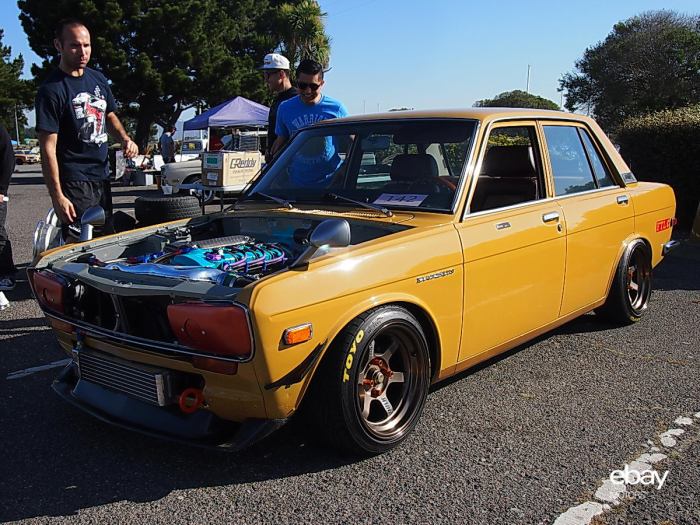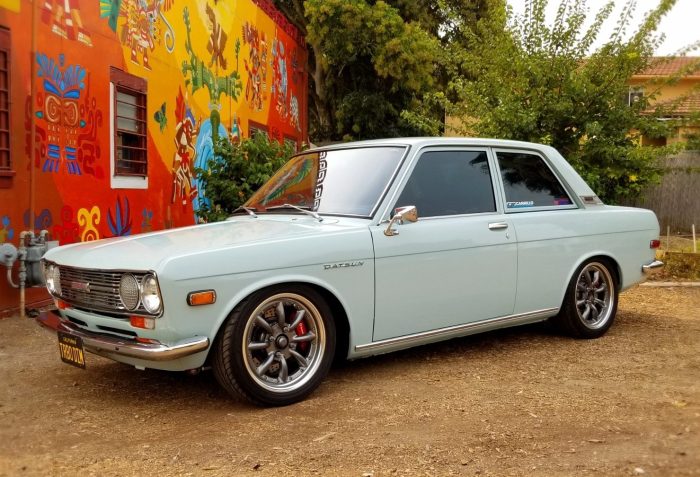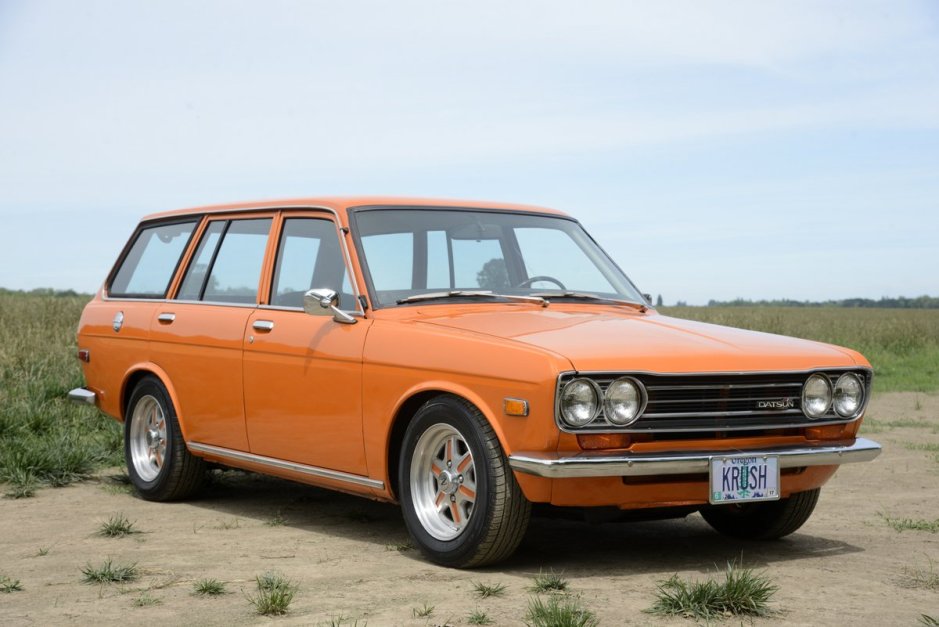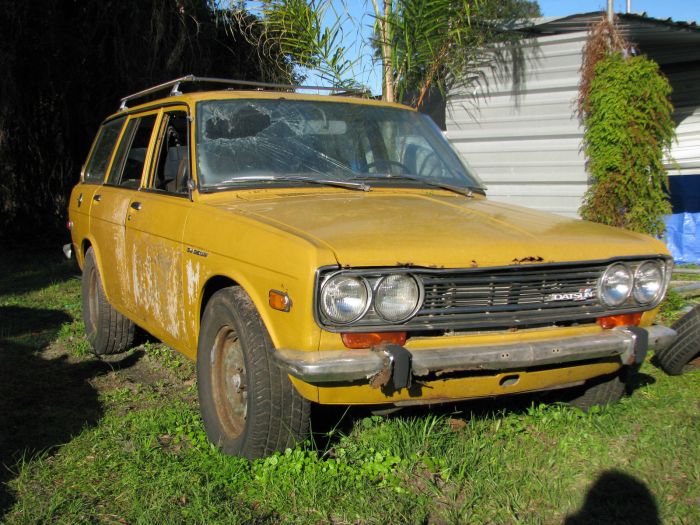1971 Datsun 510, a name that resonates with car enthusiasts, signifies a pivotal moment in automotive history. This compact sedan, a product of Japan’s burgeoning automotive industry, not only challenged the established American dominance but also redefined what a performance car could be.
It was a time when the world was embracing fuel efficiency and practicality, and the 510 emerged as a shining example of how to blend these qualities with thrilling driving dynamics.
The 510’s design, a blend of elegant simplicity and functional practicality, was a testament to the Japanese approach to engineering. Underneath its unassuming exterior lay a robust and well-engineered platform that delivered a level of handling and performance that surprised many.
It was a car that could seamlessly transition from everyday commutes to thrilling weekend adventures, a true testament to its versatility.
Historical Context

The 1970s was a pivotal decade for the automotive industry, marked by significant shifts in consumer preferences, technological advancements, and global economic challenges. The oil crisis of 1973, triggered by the Arab oil embargo, led to a surge in demand for fuel-efficient vehicles, and manufacturers responded by prioritizing smaller, more economical models.
This era also witnessed the rise of Japanese carmakers, who were known for their reliable and affordable vehicles, challenging the dominance of American and European brands.
Datsun’s Position in the Market
Datsun, the international brand of Nissan, emerged as a prominent player in the global automotive market during the 1970s. The company had established a strong reputation for producing reliable and fuel-efficient vehicles, appealing to consumers seeking alternatives to larger, gas-guzzling American cars.
Datsun’s success was fueled by its focus on affordability, practicality, and quality, attracting a growing segment of budget-conscious buyers.
The 510’s Role in the Datsun Lineup
The Datsun 510, introduced in 1968, played a crucial role in solidifying Datsun’s position in the North American market. It was positioned as a compact sedan offering a blend of performance, efficiency, and affordability. The 510’s sporty handling, combined with its economical engine, made it a popular choice among young drivers and enthusiasts.
Its success helped Datsun gain a foothold in the American market, paving the way for its subsequent growth and expansion.
Performance and Handling: 1971 Datsun 510

The Datsun 510 was not just a stylish and affordable car; it was a true performance machine that challenged established rivals. Its combination of a potent engine, well-engineered suspension, and lightweight construction made it a formidable competitor on the road and the racetrack.
Engine Specifications and Performance, 1971 Datsun 510
The 510’s heart was a 1.6-liter, four-cylinder engine, known as the L16. This engine was a masterpiece of simplicity and efficiency, featuring a single overhead camshaft, a cast-iron block, and an aluminum head. The L16 was available in various states of tune, producing between 88 and 110 horsepower.
The 1971 Datsun 510, a legendary car known for its handling and performance, was a game-changer in the automotive world. It paved the way for future Datsun models, like the 1979 Datsun B210 , which built upon the 510’s success with its own unique features.
While the B210 offered fuel efficiency and a more compact design, the 510 remains a coveted classic for its sporty heritage and driving experience.
While the power figures might seem modest by today’s standards, they were impressive for the time, particularly considering the car’s light weight.The L16 was known for its smooth and responsive power delivery, making the 510 a joy to drive.
It was also incredibly reliable, a testament to Datsun’s engineering prowess.
The 1971 Datsun 510 was a game-changer, offering a blend of sporty handling and affordability that took the world by storm. While the 510 focused on practicality, Datsun’s other star, the 1975 Datsun 260Z , took a different approach, prioritizing performance and style.
The 510’s legacy, however, lives on, inspiring generations of car enthusiasts with its blend of driver engagement and value for money.
Suspension and Chassis
The 510’s handling was legendary, and its suspension design played a crucial role in its success. It featured a MacPherson strut front suspension and a live rear axle with semi-elliptic leaf springs. This combination provided a balance of comfort and control, allowing the 510 to corner with precision and stability.The 510’s chassis was also exceptionally rigid, contributing to its handling prowess.
It was built using a combination of steel and aluminum, resulting in a lightweight yet strong structure. This lightweight construction also helped to improve the car’s acceleration and fuel economy.
Racing Success and Impact
The Datsun 510’s performance on the racetrack was nothing short of phenomenal. It quickly became a dominant force in various racing series, including Sports Car Club of America (SCCA) and the Trans-Am Series.
- In SCCA competition, the 510 was practically unbeatable, winning numerous championships in the B Production class. Its lightweight design, agile handling, and reliable engine made it a formidable competitor against much larger and more powerful cars.
- In the Trans-Am Series, the 510 competed against the likes of Ford Mustang and Chevrolet Camaro. While it faced tougher competition in this series, the 510 still managed to achieve impressive results, including several podium finishes.
The 510’s racing success had a significant impact on the automotive industry. It demonstrated that a small, affordable car could be competitive against much larger and more expensive rivals. It also helped to establish Datsun as a serious player in the performance car market.
The 1971 Datsun 510, a true icon of the era, offered a blend of affordability and performance that made it a hit with drivers. While the 510 was known for its handling and practicality, Datsun also offered a more luxurious and sporty option with the 1978 Datsun 280Z.
This iconic Z-car, with its sleek design and powerful engine, solidified Datsun’s reputation for building desirable vehicles that appealed to a wide range of enthusiasts. The legacy of the 510, however, continues to inspire car lovers today, showcasing the brand’s ability to create both practical and performance-oriented vehicles.
Cultural Impact

The Datsun 510 wasn’t just a car; it was a cultural phenomenon that resonated with enthusiasts and shaped the landscape of car culture. Its affordability, performance, and versatility made it a favorite among a diverse group of drivers, from daily commuters to competitive racers.
Popularity Among Enthusiasts
The 510’s popularity among enthusiasts stemmed from its unique blend of practicality and performance. It was a car that could be enjoyed for its everyday usability while also being readily modified for track-day thrills. Its nimble handling, responsive engine, and rugged build quality made it a joy to drive, both on the open road and on the race track.
The 510’s reputation for reliability and ease of maintenance further solidified its appeal among car enthusiasts, who appreciated its ability to withstand the rigors of regular use and modification.
Collecting and Restoring

The 1971 Datsun 510, a true automotive icon, has captured the hearts of enthusiasts for decades. Its sleek design, sporty performance, and legendary reliability have made it a sought-after collectible. For those seeking to own and restore a piece of automotive history, the 510 presents a rewarding experience.
Model Variations and Trim Levels
The 1971 Datsun 510 was available in various model variations and trim levels, offering a range of choices for buyers. The most common models included the 510 2-Door Sedan, 4-Door Sedan, and the 4-Door Wagon. Each model was further divided into trim levels, each with its own unique features and specifications.
- 510 2-Door Sedan:The base model, often referred to as the “Standard” or “Deluxe” trim, offered a no-frills driving experience. It featured a 1.6-liter engine, vinyl upholstery, and basic amenities.
- 510 4-Door Sedan:This model offered the same powertrain and features as the 2-Door Sedan, but with the added convenience of two additional doors.
- 510 4-Door Wagon:This model was the most practical option, offering ample cargo space and versatility. It came equipped with a 1.6-liter engine and similar features to the sedan models.
- 510 2-Door Sedan (Sport):This model, known as the “Sport” trim, offered a more performance-oriented experience. It featured a larger 1.8-liter engine, upgraded suspension, and sportier styling elements.
Current Market Value and Desirability
The 1971 Datsun 510 has become a highly sought-after collectible car, with values steadily increasing over the years. The desirability of a 510 is influenced by several factors, including condition, rarity, and modifications.
- Condition:Well-maintained and original examples are highly prized, commanding top dollar in the market. Cars in excellent condition with low mileage can fetch tens of thousands of dollars.
- Rarity:Certain models, such as the Sport trim, are less common and therefore more valuable. Cars with unique features or options can also increase in desirability.
- Modifications:While some modifications can enhance the value of a 510, others can diminish it. Cars that have been heavily modified or restored with non-original parts may not be as desirable to collectors.
Tips and Advice for Restoring and Maintaining a 1971 Datsun 510
Restoring and maintaining a 1971 Datsun 510 can be a rewarding experience, but it requires dedication and knowledge. Here are some tips and advice to help you get started:
- Research:Before starting any restoration project, it’s essential to do your research. Familiarize yourself with the different model variations, trim levels, and common issues. Consult with experts and join online forums to gather information.
- Find a Good Mechanic:Having a reliable mechanic who specializes in classic cars is crucial. They can help you diagnose problems, source parts, and perform repairs.
- Source Parts:Finding original parts for a 510 can be challenging, but there are several resources available. Online retailers, classic car parts suppliers, and salvage yards are good starting points.
- Document Your Progress:Keep detailed records of your restoration process. This will help you track your progress, identify any issues, and ensure that you don’t miss any steps.
Closing Summary

The 1971 Datsun 510’s legacy extends far beyond its initial impact on the automotive scene. Its influence can be seen in the evolution of compact performance cars, and its enduring popularity among enthusiasts speaks volumes about its timeless appeal. The 510 continues to be a sought-after classic, a testament to its engineering excellence and its role in shaping automotive history.